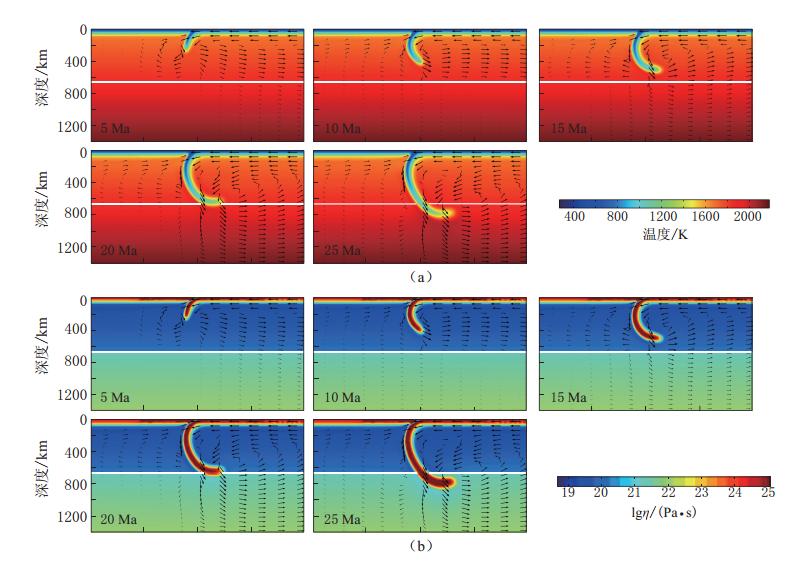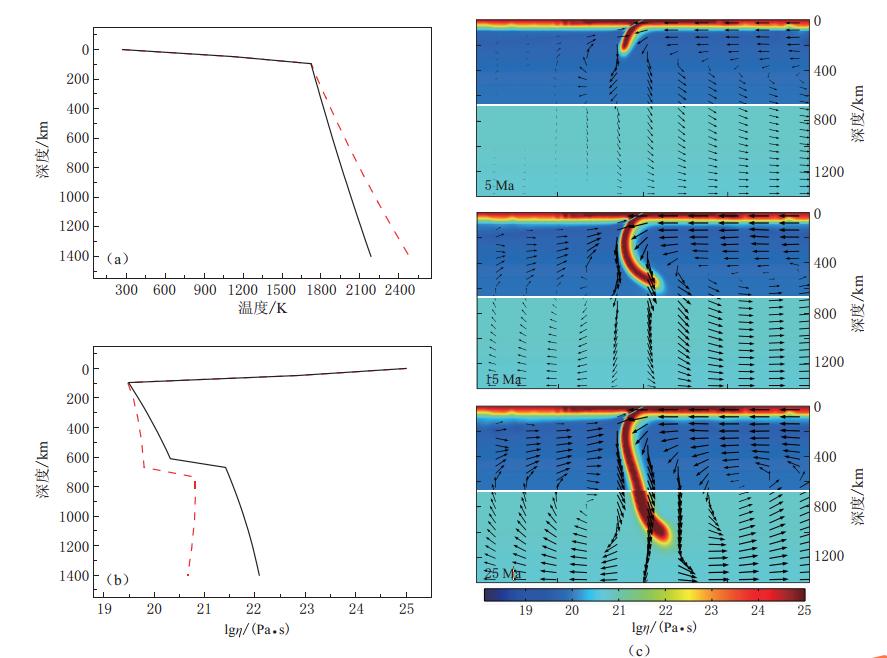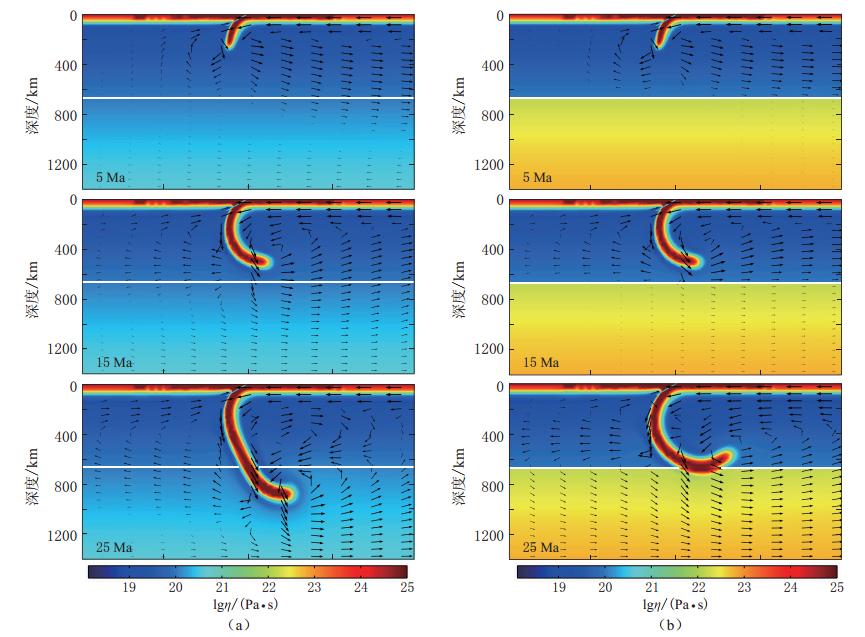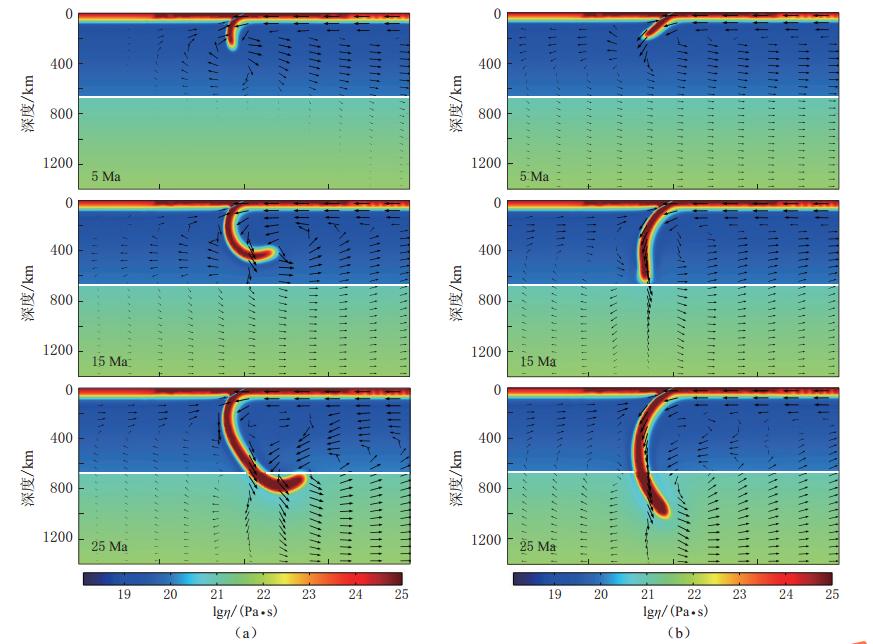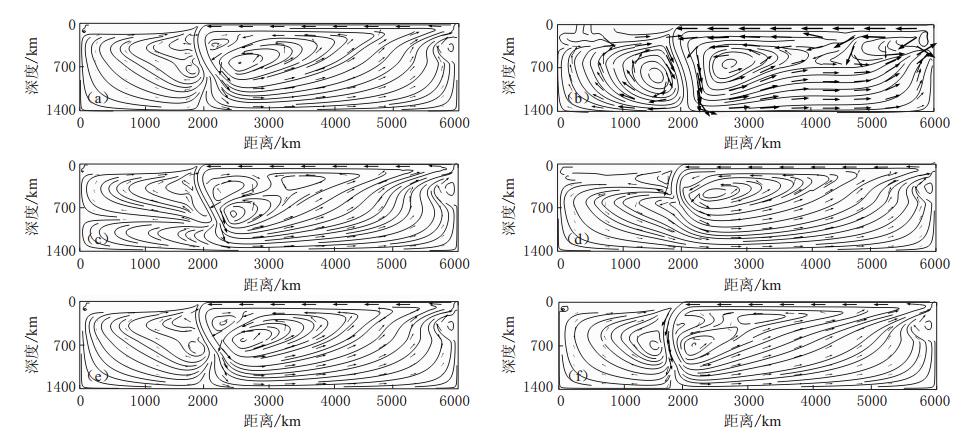Modeling the dynamic process of slab subduction based on temperature-dependent thermal coefficients
-
摘要: 热传导系数和热膨胀系数是影响板块俯冲动力学过程的两个重要参数. 由于地球介质的不均匀性,热系数也会随深度发生变化.然而,这种变化在地球动力学模拟研究中往往被忽略.本文针对随温度变化的热传导系数和热膨胀系数, 模拟板块俯冲的动力学过程,分析热系数、黏度对板块俯冲形态的影响及其对应的地幔对流特征.结果表明,依温度变化的热传导系数和热膨胀系数会影响地幔温度及黏度分布,进而改变板块的俯冲角度;黏度是控制板块俯冲动力学演化过程的重要因素;地幔对流受黏度结构的影响,呈现分层对流及局部多个对流环等多种不同形态的对流场特征.Abstract: The thermal conductivity and expansion coefficients are two significant parameters that have influence on the dynamic process of slab subduction. Due to the heterogeneity of Earth medium, these two coefficients are usually variable with depth. Unfortunately, such variations are often ignored in current modeling studies of geodynamics. The present study refers to the temperature-dependent thermal conductivity and expansion to simulate the dynamic process of slab subduction. The impact of thermal parameters and viscosity on slab geometry and the corresponding characteristics of mantle convection are analyzed. The modeling results show that the temperature-dependent thermal conductivity and expansion affect the subduction angle by changing the thermal and viscosity structure. The viscosity plays a critical role in controlling the slab dynamic evolution. The mantle convection is affected by viscosity structure and exhibits different patterns, such as layered convection and local multiple convection loops, etc.
-
Keywords:
- slab subduction /
- viscosity structure /
- mantle convection /
- numerical modeling
-
-
图 3 热系数对板块俯冲演化的影响(a)、(b)分别为模型1(黑色实线)和模型2(红色虚线)的热结构和黏度结构,(c)为俯冲经历5,15和25 Ma后模型2的黏度演化. 图中白色实线表示上、下地幔的分界线,箭头表示流速
Figure 3. Influence of thermal coefficients on slab subduction evolution (a)-(b)Temperature and viscosity depth profiles for model 1(black solid line) and model 2(red dashed line);(c)Viscosity profiles for model 2 after 5,15 and 25 Ma evolution. The white line denotes the boundary of upper and lower mantle,and the arrows represent fluid velocities
图 3 地幔黏度结构对板块俯冲演化的影响(a)模型3,ηl/ηu=1;(b)模型4,ηl/ηu=100.白色实线表示上、下地幔的分界线,箭头表示流速
Figure 3. Influence of mantle viscosity structure on slab subduction evolution(a)Model 3 with ηl/ηu=1;(b)Model 4 with ηl/ηu=100. The white line denotes the boundary of upper and lower mantle,and the arrows represent fluid velocities
图 5 板块边界剪切带黏度对板块俯冲演化的影响(a)模型5,ηsz=5×1020 Pa · s,(b)模型6,ηsz=3×1021 Pa · s. 白色实线表示上、 下地幔的分界线,箭头表示流速
Figure 5. Influence of the shear zone viscosity at the plate boundary on slab subduction evolution(a)Model 5 with ηsz=5×1020 Pa · s;(b)Model 6 with ηsz=3×1021 Pa · s. The white line denotes the boundary of upper and lower mantle,and the arrows represent fluid velocities
表 1 模型固定参数
Table 1 Fixed model parameters

表 2 黏度相关参数
Table 2 Viscosity parameters

表 3 模型参数
Table 3 Model parameters

-
傅容珊, 冷伟, 常筱华. 2005. 地幔对流与深部物质运移研究的新进展[J]. 地球物理学进展, 20(1): 170-179. Fu R S, Leng W, Chang X H. 2005. Advancements in the study of mantle convection and the material movements in deep Earth interior[J]. Progress in Geophysics, 20(1): 170-179 (in Chinese).
高翔, 张健, 孙玉军, 吴时国. 2012. 马尼拉海沟俯冲带热结构的模拟研究[J]. 地球物理学报, 55(1): 117-125. Gao X, Zhang J, Sun Y J, Wu S G. 2012. A simulation study on the thermal structure of Manila trench subduction zone[J]. Chinese Journal of Geophysics, 55(1): 117-125 (in Chinese).
朱桂芝, 石耀霖, 陈石, 张怀. 2009. 西太平洋板块向东北地区深部俯冲的数值模拟[J]. 地球物理学报, 52(4): 950-957. Zhu G Z, Shi Y L, Chen S, Zhang H. 2009. Numerical simulations on deep subduction of western Pacific Plate to NE China[J]. Chinese Journal of Geophysics, 52(4): 950-957 (in Chinese).
Allègre C J, Staudacher T, Sarda P. 1986. Rare gas systematics: Formation of the atmosphere, evolution and structure of the Earth's mantle[J]. Earth Planet Sci Lett, 81(2): 127-150.
Bercovici D. 2003. The generation of plate tectonics from mantle convection[J]. Earth Planet Sci Lett, 205(3): 107-121.
Billen M I, Hirth G. 2005. Newtonian versus non-Newtonian upper mantle viscosity: Implications for subduction initiation[J]. Geophys Res Lett, 32(19): L19304. doi:10.1029/2005GL023457.
Billen M I, Hirth G. 2007. Rheologic controls on slab dynamics[J]. Geochem Geophys Geosyst, 8(8): Q08012. doi:10.1029/2007GC001597.
Bouhifd M A, Andrault D, Fiquet G, Richet P. 1996. Thermal expansion of forsterite up to the melting point[J]. Geophys Res Lett, 23(10): 1143-1146.
Christensen U R. 1996. The influence of trench migration on slab penetration into the lower mantle[J]. Earth Planet Sci Lett, 140(1): 27-39.
Dubuffet F, Rabinowicz M, Monnereau M. 2000. Multiple scales in mantle convection[J]. Earth Planet Sci Lett, 178(3): 351-366.
Forte A M, Peltier W R, Dziewonski A M. 1991. Inferences of mantle viscosity from tectonic plate velocities[J]. Geophys Res Lett, 18(9): 1747-1750.
Fukao Y, Widiyantoro S, Obayashi M. 2001. Stagnant slabs in the upper and lower mantle transition region[J]. Rev Geophys, 39(3): 291-323.
Gurnis M, Hager B H. 1988. Controls of the structure of subducted slabs[J]. Nature, 335: 317-321.
Hager B H, Curnis M. 1987. Mantle convection and the state on the Earth's interior[J]. Rev Geophys, 25(6): 1277-1285.
Hager B H, Clayton R W. 1989. Constraints on the structure of mantle convection using seismic observations, flow models, and the geoid[G]//Mantle Convection: Plate Tectonics and Global Dynamics. New York: Gordon and Breach Science Publisher: 657-763.
Hirth G, Kohlstedt D. 2003. Rheology of the upper mantle and the mantle wedge: A view from the experimentalists, in inside the subduction factory[J]. Geophysical Monograph, 138: 83-105.
Hofmeister A M, Dong J, Branlund J M. 2014. Thermal diffusivity of electrical insulators at high temperatures: Evidence for diffusion of bulk phonon-polaritons at infrared frequencies augmenting phonon heat conduction[J]. J Appl Phys, 115(16): 163517.
Karato S, Wu P. 1993. Rheology of the upper mantle: A synthesis[J]. Science, 260(5109): 771-778.
Karato S, Jung H. 2003. Effects of pressure on high-temperature dislocation creep in olivine[J]. Philos Mag, 83(3): 401-414.
Kincaid C, Sacks I S. 1997. Thermal and dynamical evolution of the upper mantle in subduction zones[J]. J Geophys Res, 102(B6): 12295-12315.
King S D, Masters G. 1992. An inversion for radial viscosity structure using seismic tomography[J]. Geophys Res Lett, 19(15): 1551-1554.
Lallemand S, Heuret A, Boutelier D. 2005. On the relationships between slab dip, back-arc stress, upper plate absolute motion, and crustal nature in subduction zones[J]. Geochem Geophys Geosyst, 6(9): Q09006. doi:10.1029/2005GC000917.
Manea V, Gurnis M. 2007. Subduction zone evolution and low viscosity wedges and channels[J]. Earth Planet Sci Lett, 264(1): 22-45.
Kirby S H, Stein S, Okal E A, Rubie D C. 1996. Metastable mantle phase transformations and deep earthquakes in subducting oceanic lithosphere[J]. Rev Geophys, 34(2): 261-306.
Mitrovica J X, Peltier W R. 1993. The inference of mantle viscosity from an inversion of the Fennoscandian relaxation spectrum[J]. Geophys J Int, 114(1): 45-62.
Monnereau M, Quere S. 2001. Spherical shell models of mantle convection with tectonic plates[J]. Earth Planet Sci Lett, 184(3): 575-587.
Peltier W R. 1989. Mantle viscosity[G]//Mantle Convection: Plate Tectonics and Global Dynamics. New York: Gordon and Breach Science Publisher: 389-475.
Ritsema J. 2000. Evidence for shear velocity anisotropy in the lowermost mantle beneath the Indian Ocean[J]. Geophys Res Lett, 27(7): 1041-1044.
Rodríguez-González J, Negredo A M, Petricca P, Carminati E. 2009. Modeling with COMSOL the interaction between subducting plates and mantle flow[C]. COMSOL User's Conference. Milan, October 14-16, 2009.
Rodríguez-González J, Negredo A M, Billen M I. 2012. The role of the overriding plate thermal state on slab dip variability and on the occurrence of flat subduction[J]. Geochem Geophys Geosyst, 13(1): Q01002. doi:10.1029/2011GC003859.
Stacey F D, Fu R S, Spiliopoulos S. 1989. Viscosity structure implied by mantle convection[J]. Phys Earth Planet Inter, 55(1): 1-9.
Stein C A, Stein S. 1992. A model for the global variation in oceanic depth and heat flow with lithospheric age[J]. Nature, 359(6391): 123-129.
Torii Y, Yoshioka S. 2007. Physical conditions producing slab stagnation: Constraints of the Clapeyron slope, mantle viscosity, trench retreat, and dip angles[J]. Tectonophysics, 445(3): 200-209.
Tosi N, Yuen D A, de Koker N, Wentzcovitch R M. 2013. Mantle dynamics with pressure- and temperature-dependent thermal expansivity and conductivity[J]. Phys Earth Planet Inter, 217: 48-58.
van der Hilst R D, Widiyantoro S, Engdahl E R. 1997. Evidence for deep mantle circulation from global tomography[J]. Nature, 386(6625): 578-584.
van der Hilst R D, Karason H. 1999. Compositional heterogeneity in the bottom 1000 kilometers of Earth's mantle: Toward a hybrid convection model[J]. Science, 283(5409): 1885-1888.
Xu Y S, Shankland T J, Linhardt S, Rubie D C, Langenhorst F, Klasinski K. 2004. Thermal diffusivity and conductivity of olivine, wadsleyite and ringwoodite to 20 GPa and 1373 K[J]. Phys Earth Planet Int, 143/144: 321-336.
Yamaji A. 1992. Periodic hotspot distribution and small-scale convection in the upper mantle[J]. Earth Planet Sci Lett, 109(1): 107-116.
Zhong S, Gurnis M. 1997. Dynamic interaction between tectonic plates, subducting slabs, and the mantle[J]. Earth Interactions, 1(3): 1-18.
Zhong S, Zuber M T, Moresi L, Gurnis M. 2000. Role of temperature-dependent viscosity and surface plates in spherical shell models of mantle convection[J]. J Geophys Res, 105(B5): 11063-11082.




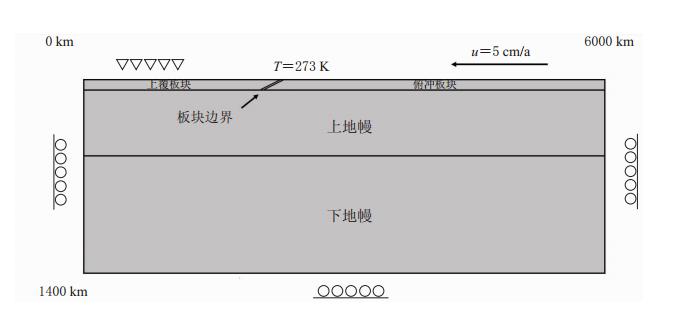
 下载:
下载:
